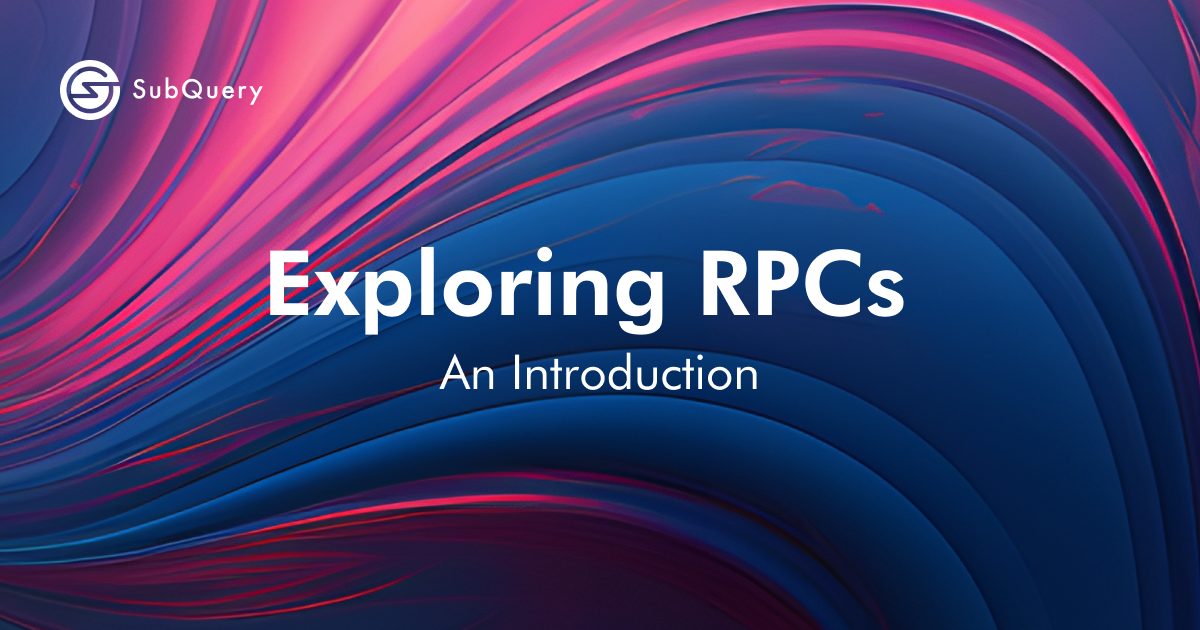Introduction
The biggest infrastructure component in dApp development is RPCs or Remote Procedure Calls, but what exactly are they?
Essentially, RPCs allow applications to communicate with the blockchain. These nodes handle important tasks like sending and receiving transactions, making queries, and keeping everything in balance. They're like the middleman, helping developers create decentralised apps (DApps) without needing to handle the entire node themselves.
What is an RPC Node Provider?
RPC node providers simplify blockchain integration for crypto applications by managing and maintaining RPC endpoints to blockchain nodes. They eliminate the need for teams to run their own nodes, saving on hardware and infrastructure costs.
By leasing distributed infrastructure, RPC node providers enable developers to focus on app development rather than node management. Clients typically pay for usage based on request volume or through subscription models.
Their function can be likened to e-commerce platforms where modern RPC node providers offer seamless sign-up, endpoint customization, and easy integration into app codebases.
What is an RPC endpoint?
An RPC endpoint is where a program sends requests to access server data. A node with the right software can respond to these requests. When an RPC endpoint runs on a node, it's the service your dApp uses to get blockchain info for users. Simply put, all RPC endpoints work on RPC nodes, and vice versa.
Public vs Private RPC endpoints - the differences
- Public RPC Endpoint:
Public RPC endpoints are available for anyone and are generally used for testing and development purposes.
- Private RPC Endpoint:
Private RPC endpoints are only accessible to the individuals who own them and are typically used for production-level applications. They run at your request and may come with service-level agreements.
How to Access RPC Nodes
Use an RPC Node Provider
Node providers handle node setup, management, and maintenance for your dApp, ensuring smooth operation—an essential practice for web3 builders.
By choosing a node provider, developers free themselves from setup and maintenance tasks. Leading providers offer integrated features, allowing developers to focus on building innovative products.
Why using an RPC node provider is better than running your own RPC node?
Node providers not only save you time and resources on node management but also ensure round-the-clock, dependable, low-latency node access. Your node will be handled by a seasoned team committed to optimizing its performance.
While running your own node offers extensive customisation options, it may not provide the seamless and hassle-free developer experience you desire.
Are RPCs decentralised?
Many leading RPC providers today are highly centralised. The call for decentralised alternatives to these services is crucial for the foundation of the next generation of dApps. We need decentralisation without compromise.SubQuery is here to decentralise RPC services to change the game.
How to Get Started Using SubQuery’s Free Decentralised Public RPC Endpoints
SubQuery Network has launched decentralised public RPC endpoints starting with Ethereum, Base, Polygon, Arbritrum, and Ethereum Sepolia which are all currently free.
Behind these RPC endpoints is a network of independent RPC providers operating around the world in a decentralised, trustless, and unstoppable way.
Find out more information on how to access them here.
How will SubQuery Network be different from other RPC providers?
RPC endpoints traditionally hinder the performance of data indexers and apps, prioritising network validation over efficient querying. This leads to high costs and inefficiencies.
To tackle this, SubQuery has launched the SubQuery Data Node to mitigate this. This improved RPC node will boost querying capabilities with optimised endpoints and streamlined transaction filtering. It's community-driven and open-source, initially supporting top layer-2s and EVM networks for decentralised operation on the SubQuery Network.
The Data Node is also open source, allowing people to contribute, extend, or fork the implementation in any way. SubQuery currently provides these Data Nodes:
- data-node-go-ethereum (forked from ethereum/go-ethereum for Ethereum and testnets).
- Public (beta) node https://ethereum.node.subquery.network/public
- data-node-op-geth (forked from ethereum-optimism/op-geth for Optimism, Base, and testnets). Public (beta) node coming soon
Read more about the Data Node, including how to run one yourself, here.
From there we will enhance and democratise RPCs to make them ultra-performant as well as cheaper to run. This will be completed by the end of 2024. Read more about this here.
What's Next?
SubQuery is on a mission to make RPCs more accessible to everyone. We’re tackling EIP-4444 and introducing the Sharded Data Node, which will lower the cost of running RPCs for node providers. This involves splitting up block ranges among different operators, so each one can focus on specific blocks, improving query performance without the need for constant data syncing.
About SubQuery
SubQuery Network is innovating web3 infrastructure with tools that empower builders to decentralise the future. Our fast, flexible, and open data indexer supercharges dApps on over 160 networks, enabling a user-focused web3 world. Soon, our Data Node will provide breakthroughs in the RPC industry, and deliver decentralisation without compromise. We pioneer the web3 revolution for visionaries and forward-thinkers. We’re not just a company — we’re a movement driving an inclusive and decentralised web3 era. Let’s shape the future of web3, together.
Linktree | Website | Discord | Telegram | Twitter | Blog | Medium | LinkedIn | YouTube







